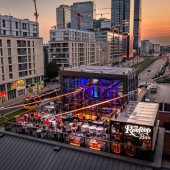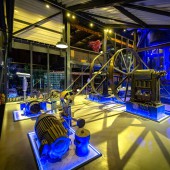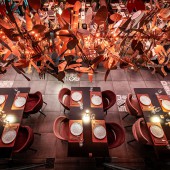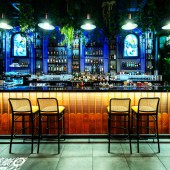
| THE AWARD |
| CATEGORIES |
| REGISTRATION |
| SUBMIT YOUR WORK |
| ENTRY INSTRUCTIONS |
| TERMS & CONDITIONS |
| PUBLICATIONS |
| DATES & FEES |
| METHODOLOGY |
| CONTACT |
| WINNERS |
| PRESS ROOM |
| GET INVOLVED |
| DESIGN PRIZE |
| DESIGN STORE |
| THE AWARD | JURY | CATEGORIES | REGISTRATION | PRESS | WINNERS | PUBLICATIONS | ENTRY INSTRUCTIONS |
Amar Beirut Restaurant by MARINA KHALIL |
Home > Winners > Design #155149 >Interview |
 |
|
FS: What is the main principle, idea and inspiration behind your design?
MK: The main principle behind the design of the Amar Beirut project is to honor the historical and cultural heritage of the site while seamlessly blending it with contemporary aesthetics. The idea was to transform the space into a distinctive restaurant that pays homage to its industrial past, particularly its former role in cutlery production, while introducing modern design elements that create a captivating and immersive atmosphere.
FS: What has been your main focus in designing this work? Especially what did you want to achieve?
MK: In designing the Amar Beirut project, my main focus was to create a space that seamlessly integrates the historical significance of the Norblin Factory with modern design elements, ensuring a harmonious blend of past and present. The goal was to achieve a distinctive and immersive environment where guests can appreciate the rich industrial heritage while enjoying contemporary aesthetics and comfort.
FS: What are your future plans for this award winning design?
MK: My future plans for the Amar Beirut project are multifaceted. Firstly, I aim to expand the concept by adapting the design principles to other historic industrial sites, creating unique spaces that celebrate both local heritage and modern aesthetics. Additionally, I plan to enhance the visitor experience by incorporating advanced technologies and interactive elements, such as augmented reality and smart lighting, to create an even more immersive environment. Sustainability is also a key focus. I intend to integrate more sustainable practices and materials, striving for energy efficiency and environmental responsibility in future projects. Furthermore, I want to engage more with local communities by collaborating with local artists, historians, and residents to ensure each project reflects the unique cultural narrative of its location. In summary, my goal is to expand the reach of this design philosophy, enhance the immersive experience, promote sustainability, and involve the community more deeply in the design process.
FS: How long did it take you to design this particular concept?
MK: Around 1 month
FS: Why did you design this particular concept? Was this design commissioned or did you decide to pursuit an inspiration?
MK: The design for Amar Beirut was inspired by a combination of factors. While the project was commissioned, the concept itself emerged from a deep appreciation for the site's historical significance and a desire to creatively blend it with modern design elements. The Norblin Factory's rich industrial heritage, particularly its cutlery production history, served as a profound source of inspiration. I wanted to create a space that not only preserves this heritage but also reimagines it in a way that resonates with contemporary audiences. The artistic elements, such as ceiling sculptures depicting cutlery and walls adorned with decorative jugs, were designed to honor this legacy while adding a unique and modern touch. In essence, the design concept was a response to both the commission's requirements and a personal inspiration to celebrate and innovate upon the historical narrative of the site.
FS: Is your design being produced or used by another company, or do you plan to sell or lease the production rights or do you intent to produce your work yourself?
MK: Yes, it is used by our client
FS: What made you design this particular type of work?
MK: I wanted to design a venue that tells a story, where every detail serves as a connection to the site's history while offering a modern, eclectic atmosphere. The challenge of blending these elements to create an immersive and engaging experience for visitors was a significant motivator. My goal was to honor the industrial legacy while making it relevant and appealing to contemporary audiences, resulting in a space that is both historically rich and visually captivating.
FS: Where there any other designs and/or designers that helped the influence the design of your work?
MK: The design of the Amar Beirut project was a collaborative effort of beg team, drawing inspiration from various sources such as the site's history, contemporary design trends, and client preferences. We were inspired by a collective appreciation for historical preservation and innovative design concepts. Our goal was to create a space that seamlessly integrates the past with the present, resulting in a unique and compelling final product.
FS: Who is the target customer for his design?
MK: The target customer for the design of Amar Beirut is diverse and inclusive. We aim to attract individuals who appreciate both historical heritage and modern aesthetics. This includes locals interested in exploring their city's history, tourists seeking unique cultural experiences, as well as patrons looking for a vibrant and immersive dining or entertainment venue. By catering to a broad audience, we hope to create a welcoming and engaging environment that appeals to a wide range of tastes and interests.
FS: What sets this design apart from other similar or resembling concepts?
MK: The meticulous attention to detail, from the ceiling sculptures depicting cutlery to the walls adorned with decorative jugs, creates an immersive journey through history and innovation. Additionally, the incorporation of interactive elements and advanced technologies enhances the visitor experience, setting it apart from more traditional approaches. Furthermore, the design's adaptability and scalability allow it to be applied to various historical sites and cultural contexts while maintaining its distinct character. Overall, it is this combination of historical reverence, contemporary flair, and versatility that sets the design of Amar Beirut apart from others in its class.
FS: How did you come up with the name for this design? What does it mean?
MK: The name "Amar Beirut" was chosen collaboratively with the client. "Amar" means "moon" in Arabic, symbolizing elegance, while "Beirut" represents the vibrant soul of the Lebanese capital, reflecting the restaurant's Arabic cuisine and cultural inspiration. Together, the name embodies a fusion of elegance and cultural richness, inviting patrons to experience the luminous charm of Beirut under the moonlight.
FS: Which design tools did you use when you were working on this project?
MK: During the development of the Amar Beirut project, our design team used a variety of tools including CAD software for floor plans and 3D models, graphic design software for renderings and presentations, project management tools for organization, VR technology for virtual tours, and hand sketches for initial concepts. These tools helped us streamline the design process and deliver a compelling final product.
FS: What is the most unique aspect of your design?
MK: it is this balance between historical reverence and contemporary innovation that makes our design for Amar Beirut truly unique.
FS: Who did you collaborate with for this design? Did you work with people with technical / specialized skills?
MK: yes, we worked with big team
FS: What is the role of technology in this particular design?
MK: In the design of Amar Beirut, technology plays a crucial role in enhancing the guest experience. Interactive displays offer insights into the site's history, smart lighting adapts the ambiance, and virtual reality tours provide immersive previews. We prioritize sustainability with energy-efficient solutions and utilize digital platforms for effective communication and reservations. Overall, technology enriches every aspect of our design, enhancing functionality, ambiance, and sustainability while engaging our guests.
FS: Is your design influenced by data or analytical research in any way? What kind of research did you conduct for making this design?
MK: Yes, our design for Amar Beirut is heavily influenced by data and analytical research. We conducted market research to understand current trends and customer preferences in restaurant design. Historical research into the Norblin Factory's industrial heritage informed our design decisions, while user experience research guided layout and circulation patterns. Additionally, environmental analysis helped optimize lighting and sustainability measures. Regular client consultations ensured alignment with their vision and goals. Overall, our design integrates insights from various research avenues to create a compelling and functional space.
FS: What are some of the challenges you faced during the design/realization of your concept?
MK: During the design and realization of our concept for Amar Beirut, we encountered various challenges. Balancing historical preservation with modern design, integrating technology seamlessly, and meeting sustainability goals were some key hurdles. Additionally, managing client expectations and logistical constraints required careful navigation. However, through teamwork and creativity, we overcame these challenges to deliver a captivating and functional space that exceeds expectations.
FS: How did you decide to submit your design to an international design competition?
MK: The decision to submit our design for Amar Beirut to an international design competition was driven by a desire to showcase our work on a global stage and gain recognition within the design community. After completing the project, we recognized its unique blend of historical homage, contemporary innovation, and sustainability as qualities that set it apart and made it worthy of recognition. Submitting to an international competition provided an opportunity to receive valuable feedback from industry experts, benchmark our design against other innovative projects, and potentially gain exposure to new clients and collaborators. Additionally, winning or being recognized in such a prestigious competition would validate our efforts and elevate our reputation within the design community. Ultimately, the decision to submit was a strategic one, driven by our confidence in the quality of our work and a desire to showcase our talents and capabilities to a broader audience.
FS: What did you learn or how did you improve yourself during the designing of this work?
MK: Designing Amar Beirut was not only a testament to my design skills but also a journey of personal and professional growth. I emerged from the process with a deeper understanding of historical preservation, sustainable design, and client collaboration, positioning myself as a more versatile and accomplished designer.
FS: Any other things you would like to cover that have not been covered in these questions?
MK: I'd like to express my gratitude for the opportunity to discuss the Amar Beirut project. In addition to the points covered, I want to highlight the importance of interdisciplinary collaboration, cultural appreciation, and ongoing learning in design. Working with diverse teams enriched the project, and celebrating cultural influences was integral to its success. Moving forward, I'm committed to continual innovation and pushing the boundaries of design excellence. Thank you again for the opportunity to share my insights on this project.
FS: Thank you for providing us with this opportunity to interview you.
A' Design Award and Competitions grants rights to press members and bloggers to use parts of this interview. This interview is provided as it is; DesignPRWire and A' Design Award and Competitions cannot be held responsible for the answers given by participating designers.
| SOCIAL |
| + Add to Likes / Favorites | Send to My Email | Comment | View Press-Release |




